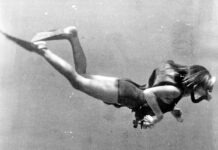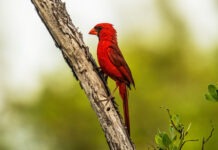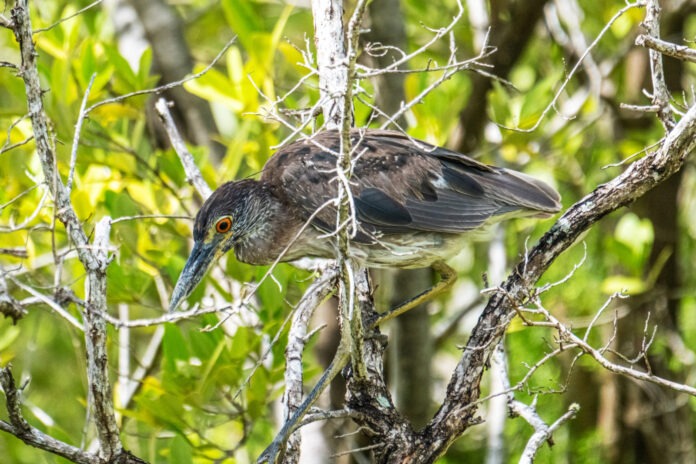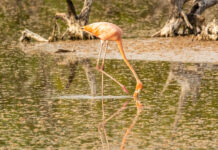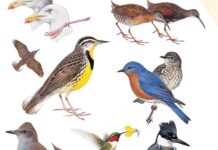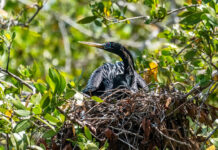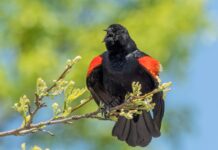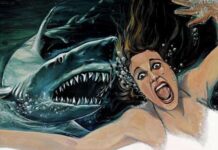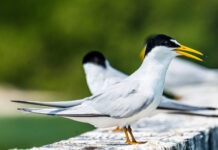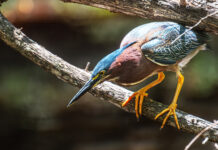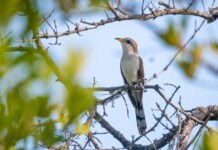I didn’t flush up the yellow-crowned night heron. The Key deer did.
But me slowing down on Watson Boulevard to get a better look at the Key deer might have inspired the half-pint ungulate to start moseying down the shoulder of the road, thus flushing the night heron.
The bird did not climb very high, just three or four feet above the ground. It flew in an unhurried straight line, parallel to my car, for 30 or 40 yards. Then it banked hard and disappeared into a thicket of leafless branches.
I drove on for a while, then got vaguely curious, turned the car around, and parked on the opposite side of the road from its point of disappearance.
At first I wasn’t sure I’d stopped at the right thicket. All I could see was an abstract collection of near-colorless twigs and branches. But then I found the bird right in the middle of it all, two feet tall and weighing about a pound and a half, leaning forward several degrees, staring down towards the ground with its pumpkin orange eyes.
Adult yellow-crowned night herons have something I’d classify as a sartorially put-together look, borderline dapper and dashing. They are gray in the body, as if wearing some kind of well-cut suit, with some white fringing in the flight feathers. They have a black, oblong head, pleasing as a fedora, underscored by a distinctive white cheek, a pair of feathers trailing to their nape, and a solid, no-nonsense, longish bill. Sometimes you catch sight of the nominate yellow crown.
Immature yellow-crowned night herons, when I see them, often bring to mind a word my friend Robert taught me – frowzy – which at first I thought he made up, but turns out to be legit English. It means scruffy or neglectful in appearance, or generally not put together.
The bird I was looking at was a mishmash of browns and blacks and grays. It takes a yellow-crown three or four years to reach adult plumage. After their first summer, they tend to get a somewhat streaky pattern in the breast and face, and this bird had none of that going on, meaning it was most likely just starting its first summer of life.
Any bird with night in the name sounds kind of cool. It brings an air of mystery. I think it’s why Edward Hopper chose “Nighthawks” for the title of his most famous painting. But the title has always bothered me a bit in its ornithological aptness.
Nighthawks, for one, aren’t actually hawks. They’re in the nightjar and goatsucker family. (Goatsucker is derived from the belief that they stole milk from goats while everyone was sleeping. Which is not true.) In an anthropomorphic sense nighthawks don’t have a lot of edge. They are not cool, composed birds that spend their evenings staring off into space. Behavior-wise, they come off more on the frenetic end of the spectrum, bordering on spastic, flying through the dark skies of the late hours in a constantly changing and discursive pattern. Of course the pattern is not random so much as improvised, guided by their ability to change direction in an instant and nab the airborne insects that make up the vast bulk of their diet. But all of this doesn’t necessarily jibe with a painting of a small group of people in a mostly empty diner, in postures that convey a sense of inarticulable beauty underscored by a rumbling of loneliness and existential dread.
Night herons, by comparison, are actual herons, built for a life of grabbing up aquatic things at their feet. Though the yellow-crown’s diet is more limited than most members of the ardeidae family, with about 80% of it made up of crabs, if they live near salt water, or crayfish if they live further inland. Of the eight species of herons found in North America, they are considered the most sedentary forager.
They used to be classified in the same family as the black-crowned night heron, but were recently moved to a family in which they are the only extant member.
In 1978, the South Florida ornithologist James Kushlan described 38 feeding tactics employed by herons. The yellow-crowned night heron has been observed to use five of them: standing, head swaying, neck swaying, pecking, and walking slowly. About 75% of their foraging time falls into the category of standing, interspersed with short periods of slow walking, which takes up about 20% of their foraging time.
My point here being that if any type of nocturnal bird feels behaviorally simpatico with the scene of what Tom Waits described as cold caffeine in a nicotine cloud portrayed in “Nighthawks” – what with their flannel gray feathers and their staring-into-space demeanor – it’s night herons, not nighthawks.
The problem, of course, is that “Nighthawks” is a poetic title. And poetic truth doesn’t always match real world facts. (There are quite a few people who will argue that poetic truth runs deeper than the facts.) And the mechanics of poetry are largely about rhythm and flow, and sadly “Night Herons” falls short, not scanning very well, lacking the same cool ring.
Also, Hopper finished the painting in 1942 and died in 1967, and the painting is one of the most well-loved images in the American visual canon. It seems unlikely to be changeable now, no matter the lack of ornithological correctness.
The yellow-crowned night heron I was watching on Big Pine spent a long time hunting in standing mode. So long that I thought about moving on before he did. But then he dropped suddenly down into the muddy puddle at the base of the thicket, snatching up some crustacean-derived calories he needed to continue on the path to adulthood.







